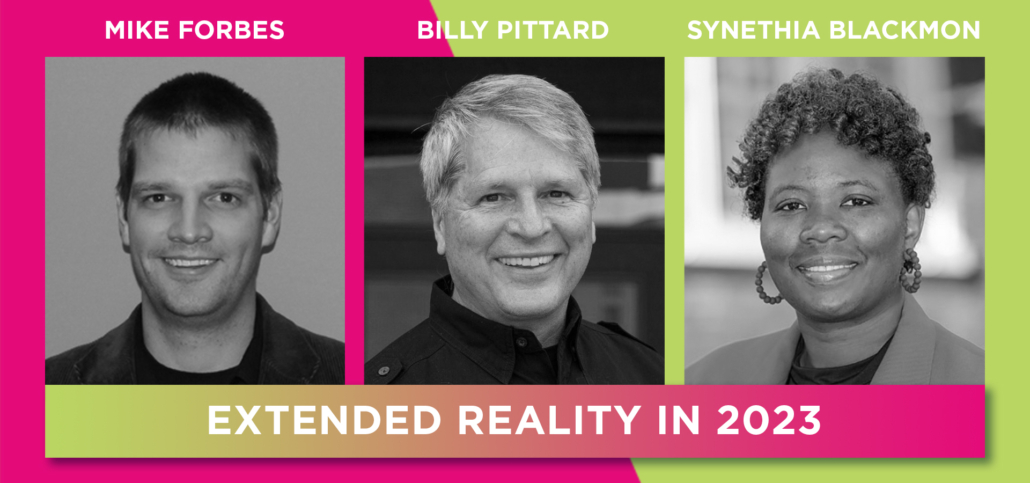Billy Pittard, Michael Forbes and Synethia Blackmon
Extended Reality in 2023
From Middle Tennessee State University’s College of Media and Entertainment, Billy Pittard, Michael (Mike) Forbes and Synethia Blackmon join the Lipstick Economy Podcast to discuss the future of virtual production and how it’s preparing its students for the new world of extended reality (XR) production.
Billy Pittard, Professor of Media Arts, is an award-winning MTSU alumnus and pioneer of four decades worth of media design and production in Hollywood and beyond. He and Mike brought a million dollar full XR capable facility to MTSU. Mike Forbes, Director of Technical Systems for the Media Arts Department, designs, installs, and maintains all of the technical systems necessary for the department’s programs, including video and film production and animation. And Synethia Blackmon, video and film production major, helps with live TV broadcasts for media arts production while representing the future of these evolving technologies in the entertainment space.
What is an extended reality stage (XR stage) and why should marketers care about it?
“What it does is it simulates a location, could be any kind of location, by displaying a 3D computer graphic background on a large high resolution LED screen, like a giant video screen behind the talent and any kind of foreground objects,” Billy says.
Just like a video game, the background moves with the camera accordingly to navigate the virtual world.
“You’re able to create these kinds of illusions in a very controlled environment. You don’t have to actually go to the desert or to the Arctic to have a background that looks like that,” Billy continues, “the LED panels themselves allow any kind of foreground that you have, like actors, to be illuminated in a way that looks completely natural to the camera. Instead of like with a green screen, people kind of look like a cutout. And, of course for the actors who are on the stage, it actually feels more like they’re in that location instead of being in some kind of weird green screen kind of situation. So, all that just means that you can do new kinds of things that you couldn’t have thought of doing before.”
How is this new technology going to change how concepts are developed for film and video?
“Well, the big idea is it just allows for a much greater range of ideas, just expression in general. Put it like this, you can have much more spectacular kinds of illusions. You know, everything we do on the screen is an illusion anyway, right? And for marketers and people in branding, this is really a powerful idea,” Billy says.
“You have a much greater palette that you can use to communicate your unique qualities.”
How does this platform fit into some of the different disciplines like animation, film and TV production skills, makeup, and all the things that come together in a production?
“One thing that I love about this project is this really brings together multiple areas to concentrate on one project. And it’s been fun to see because now we’re seeing animation students come into the TV studio and the film studio and be able to work together with other students that are film students. And it’s really cool to see them kind of collaborate,” Mike says.
With 24 hour access to the studio for students, Mike and Billy see a regular rotation of students of different media majors being able to utilize the studio and test their ideas together.
“That’s kind of a cool thing to see flourish,” Mike expresses.
Knowing that MTSU is the only university in the entire state that has this technology on campus, what about that is beneficial to students? How is that attractive to students studying film production?
“Being one of the universities to have such futuristic technology gives me and my classmates a competitive edge in the entertainment market,” Synethia says, “I approach the XR stage with renewed enthusiasm, meaning that I’m gonna learn something different about the XR stage every week. Whether it’s rendering a video or footage on the wall, whether it’s working with the red camera, which is challenging in itself, or whether it’s working with animation and trying to figure out what type of graphics do I want to set my stage every week. It’s something different.”
“So this is something that is very exciting. Yes, It’s challenging to learn. It’s a lot of different aspects of it. It’s a lot of different moving parts, you know, but like Mike said, we have a 24 hour open door. We can come in there anytime and just work and play with it, break it, fix it, and you know, it’s all for the taking. It’s for us.”
Do you see growth in women who are deciding on careers in video production with XR technology?
“I think that women are making excellent strides in video and film. I watched a movie last night, King Women, which was mostly women in the movie. Also we have producers, for instance, Queen Sugar. One of their seasons had all women producers on the cast,” Synthia expresses.
“I just feel like film is not where it used to be in the past where women were frowned upon or they felt like they can’t do anything but editing or just a little software aspects of film. So right now we are breaking glass ceilings and trying to move forward just as strong as the women are.”
Resources and Links
More information on the program: https://mtsunews.com/media-arts-xr-stage/
About Billy Pittard: https://www.mtsu.edu/faculty/billy-pittard
About Michael Forbes https://www.mtsu.edu/mediaarts/staff.php




